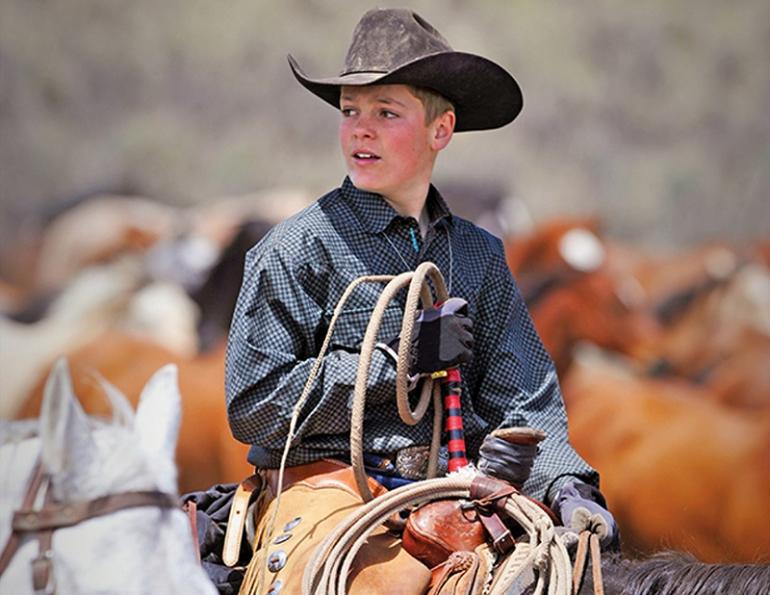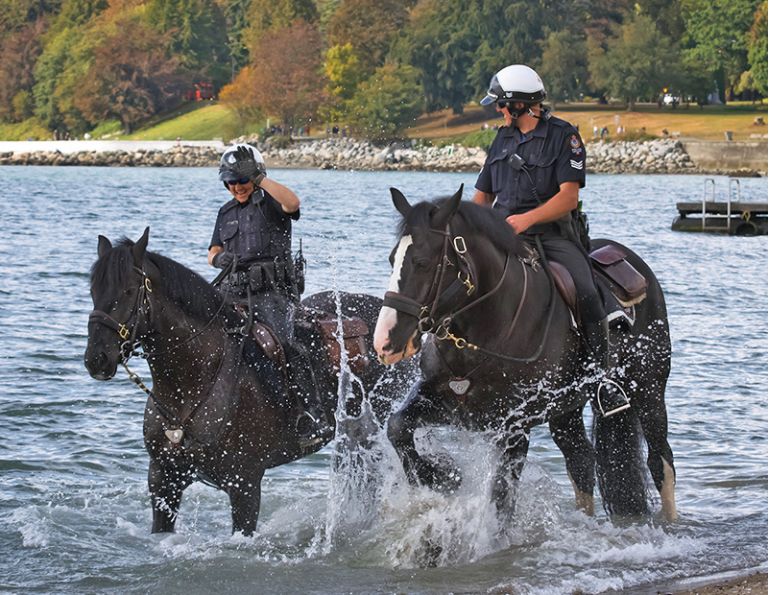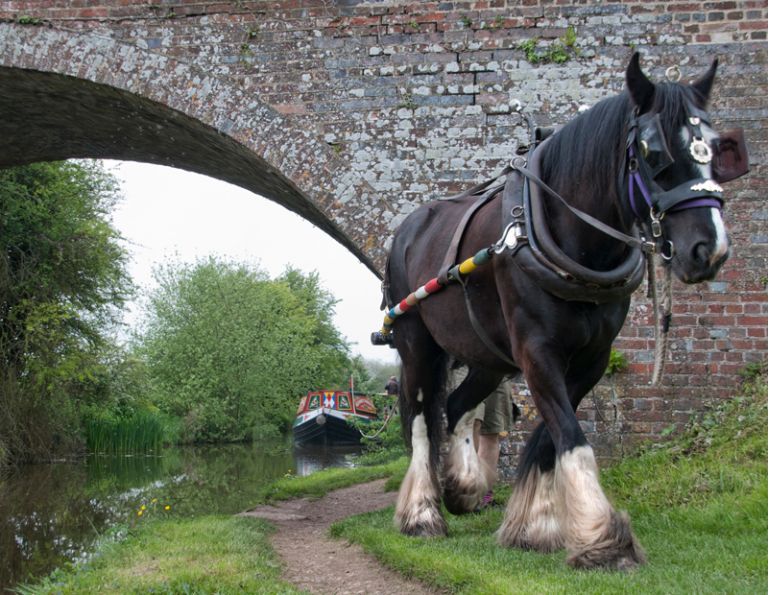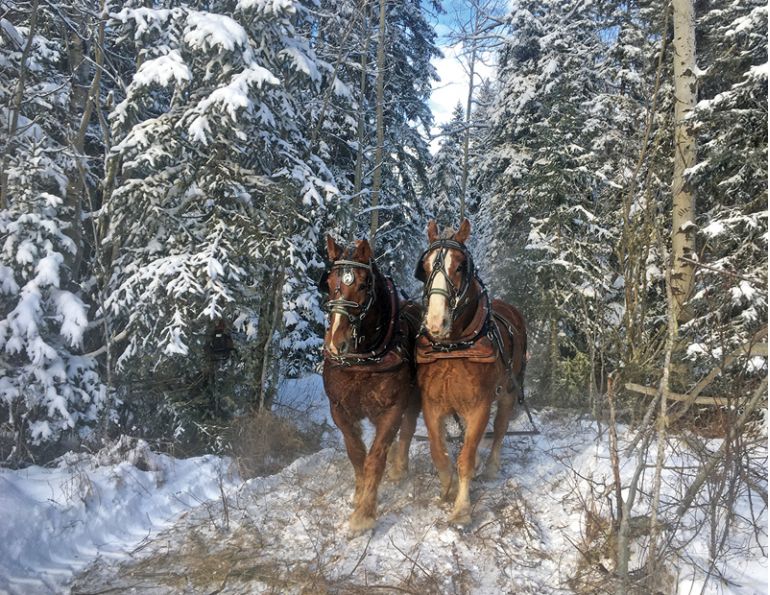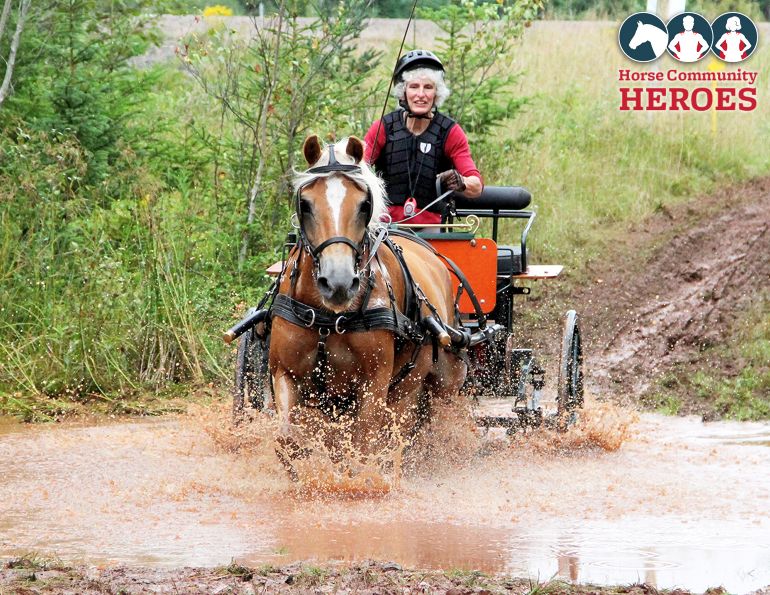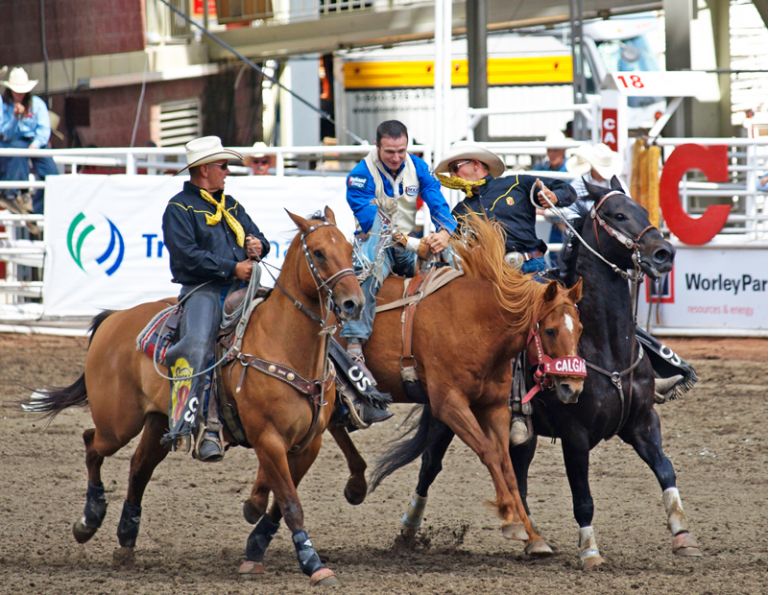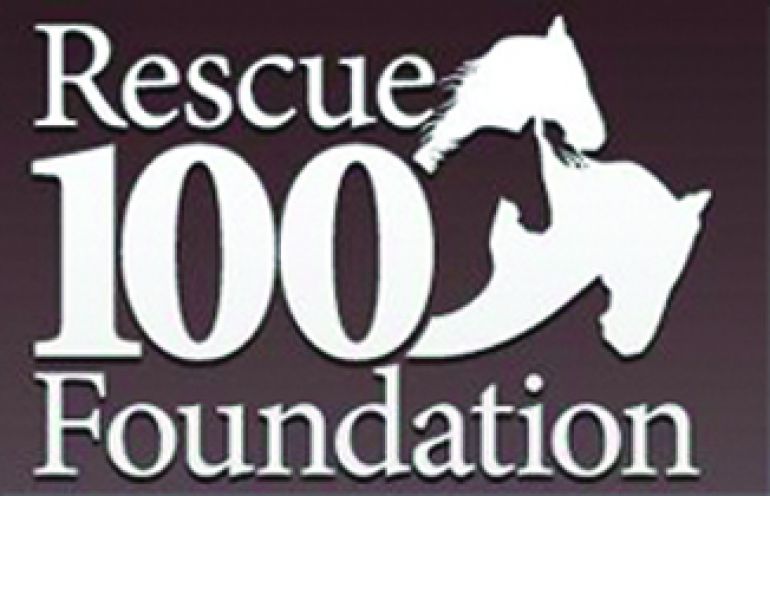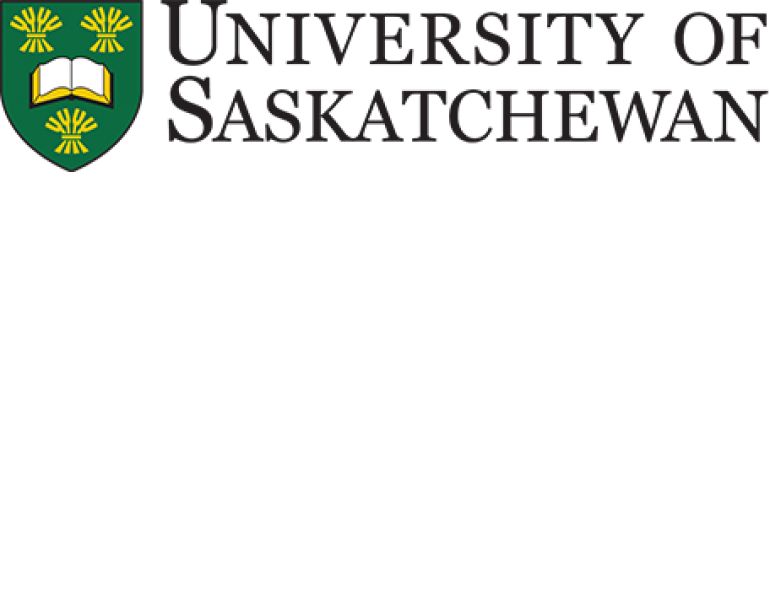By Margaret Evans
A Legacy Career Rides On
If you watch a cowboy at work today, forget that it’s the 21st century, and skip back in time to catch a glimpse of a working cowboy in the 1870s, they would look surprisingly similar. They would be doing basically the same cattle management tasks, be dressed in similar clothing, have similar core skills, and be thriving with the same horsemanship abilities that have made cowboying one of the most enduring careers for centuries.
The origin of North America’s cattle industry and the need for mounted cowboys can be credited directly to the Spanish explorers. Due mainly to rapid climate change, the horse, which evolved in North America and spread over several million years to Asia and Europe, vanished from this continent at the end of the last Ice Age some 11,000 years ago. Cattle, however, were not native to North America. But the absence of these two species was to change with the arrival of explorer Christopher Columbus.

Cowboys branding cattle at MacLeod, Alberta, 1900-1910.
“In 1493, on Columbus’ second voyage to the Americas, Spanish horses representing Equus caballus were brought back to North America, first in the Virgin Islands and, in 1519, they were reintroduced on the continent in modern-day Mexico from where they radiated through the Great Plains after escape from their owners or by pilfering,” write Drs. Jay Kirkpatrick and Patricia Fazio, both with The Science and Conservation Center, ZooMontana.
Along with the horses came cattle that were a mix of both Indian and European lineages. Managing the cattle goes back to the mid-1500s when the Spanish in Mexico established the very first ranches. Landowners put indigenous peoples on trained horses to manage the stock and taught them how to handle the wild cattle on open rangeland.
Cattle continued to be imported into the North American colonies by colonizing European countries and they also entered the southern US from the Spanish possessions in the West Indies and Mexico, then were dispersed by intercolonial trade. By the early 1700s, cattle ranching had radiated north into what would be Texas, Arizona, and New Mexico as well as southward into Argentina.
The earliest cattle in Canada were imported for the northern fur trading posts. While the original plan was to breed them and give trading posts an agricultural backyard, the efforts largely failed and the cattle were slaughtered and consumed. But as the west opened up in the early to mid-1800s with explorers, gold miners and pioneer settlers, the need for meat on the hoof became a rapidly expanding industry.
In the early 1800s, the Hudson’s Bay Company dominated the Pacific Northwest, monopolizing all trading operations from its headquarters at Fort Vancouver on the Columbia River in what is now Oregon. But its fur trading posts were far flung with forts in Kamloops, Alexandria (near Quesnel), Langley, and Victoria. Workers needed to grow their own food and raise their own livestock. Since Hudson’s Bay owned cattle in Oregon, Chief Factor John McLoughlin orchestrated the first cattle drive into the future British Columbia. According to Alastair McLean’s article in Rangelands (4)3 (June 1982), in 1846 McLoughlin’s cowboy crew herded a supply of cattle and horses to forts Kamloops and Alexandria.
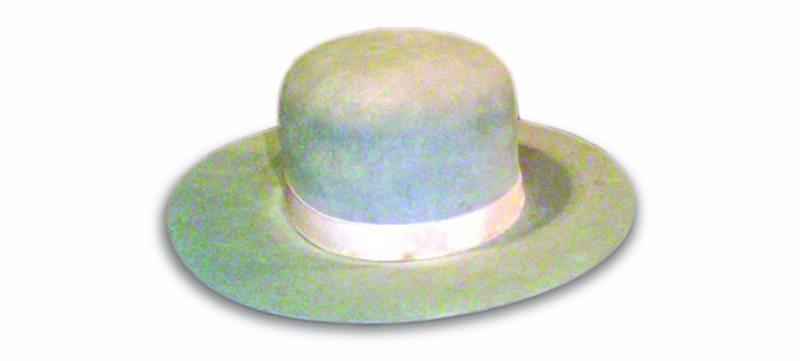
The Boss of the Plains was the first cowboy hat designed specifically for cowboys by John B. Stetson. Photo: Wikimedia/GoldTrader
In March 1858, the first major gold strike in the Fraser River valley was made at Hill’s Bar. The news exploded as gold was discovered in the Thompson River watershed. Some 33,000 prospectors and miners beat a path to the goldfields. General Joel Palmer, who had been the Superintendent of Indian Affairs in Oregon, organized a cattle drive from Oregon through Osoyoos to the Thompson valley. In 1859, he drove cattle to Fort Alexandria. Over the next decade some 22,000 cattle were moved from Oregon to the Barkerville area and the mining community.
Cattle were on the move along some of the legendary routes including the old Brigade Trail leading to the BC Interior and they were being driven by drovers, or cowboys. They were mostly Americans who influenced stock raising, handling techniques, and the ranching concept. One of the most famous cowboys of the time was Benjamin (Ben) Elam Snipes who, in 1859, drove cattle north from the Columbia River through Washington to the gold mining camps along the Fraser River in British Columbia. He knew there was a greater fortune to be made supplying hungry miners with food than pick-axing for gold. By 1864, he owned an estimated 125,000 head of cattle and 20,000 horses. In 1958, Snipes was posthumously inducted in the National Cowboy & Western Heritage Museum, Hall of Great Westerners. In the same year, cowboy and (later) politician Andrew Jackson (Jack) Splawn was also inducted into the Hall of Great Westerners. Splawn was one of the first drovers to guide cattle into Cariboo country when he was just 17 years of age.
Cattle were moving into Alberta and, according to the University of Manitoba Archives and Special Collections, the first small herd was brought in by John and George MacDougall from Montana to Morleyville in 1871-1872. In 1874, the North-West Mounted Police detachment boosted ranching, providing security and a local market. Soon, great cattle ranches were dominating western Canada including the Gang, Douglas Lake, and Empire Valley ranches in BC; the Cochrane, Bar U, Oxley, and Walrond ranches in Alberta; and the Hitchcock, Matador, and “76” ranches in Saskatchewan.
Cowboys, naturally, were at the heart of the cattle industry and their skills in cattle management were matched by their horsemanship skills that included roping, cutting, herding, gathering, and holding. But even more than their knowledge of cattle was their ability to train the horse to work the cattle, whether on the trail on in the branding pen, so that horses developed cow sense. In the process, experience, the demands of an agricultural lifestyle, and a challenging environment came to define the personality and unique qualities of cowboys as much historically as with today’s contemporary ranch hand.
“It is a lifestyle choice,” says Michael McLean, product development officer, special projects with the Bar U Ranch National Historic Site in Longview, Alberta. “While a love of the animals under your care is essential, you are at the whim of the weather, fluctuating markets, politics, natural disasters, and disease outbreak. Persistence, adaptability, and being a keen observer are traits that I think serve a cowboy well.”
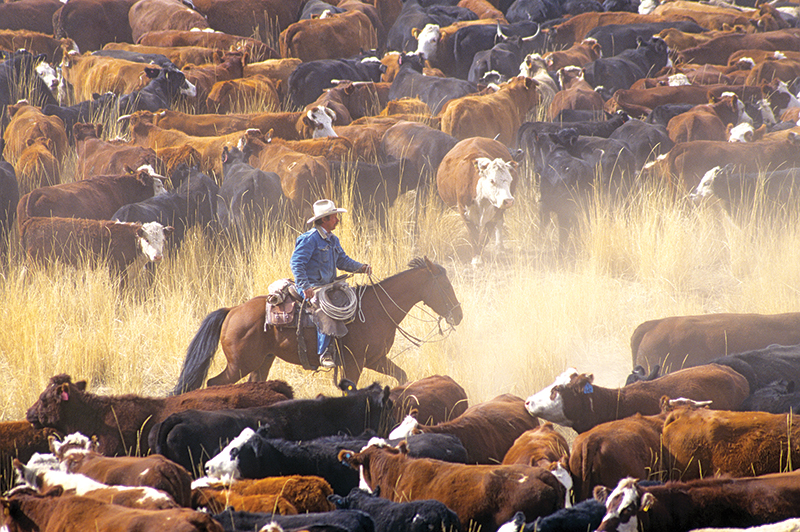
The cowboy and his reliable, hard-working horse are as much a staple of the cattle industry today as they were 150 years ago. Photo: iStock/JohnRandallAlves
The Bar U Ranch was first established as the North West Cattle Company in 1882 and was one of the four largest ranches in southern Alberta. Not only were cattle raised for meat destined for England, but through its equine program, it created the largest Percheron breeding operation of its kind in the day.
“A segment of hands in the US and Canada do embrace tradition and keep alive the stockmanship, horsemanship, and skills that were brought to North American shores by the Spanish, and which found their way into Canada along now historic cattle trails as ranching began in the Canadian west in the 1870s,” says McLean.
Mark McMillan, president of the BC Cowboy Heritage Society, agrees with McLean on the adaptability of today’s cowboy.
“I would say a cowboy has to be fairly even tempered,” he says. “Very dedicated, absolutely. Love horses, love the outdoors, and hopefully love cows. He [or she] has to be adaptable to working alone on the ranch. There are not a lot of people who would take that as a job.”
The BC Cowboy Heritage Society was established in 1996 to promote, encourage, and operate events and activities to foster the preservation of the cowboy heritage and foster community interest. The Society manages the BC Cowboy Hall of Fame, the Kamloops Cowboy Festival, the BC Cowboy Heritage Society student scholarships, and the Joe Marten Memorial Award for the Preservation of Cowboy Heritage in BC.

Most cowboys dress in the traditional practical gear, as determined by the season and the weather. Hat, long-sleeve shirt, scarf, waterproof coat or slicker, chaps and boots – each item of clothing serves a practical purpose. Photo: iStock/SimonKR
Joe Marten immigrated to Canada from Germany in 1961 and loved all things cowboy and western. He settled in Ontario, bought a horse, and became a member of the Pioneer Trail Riders Club in Toronto. He moved to the 150 Mile House area of BC after completing a three-month wilderness ride from Williams Lake to Pemberton, a distance of 800 kilometres. He and his wife, Traudl, devoted their lives to collecting and restoring anything western and cowboy, and he became renowned in silversmithing, spur-making, and engraving. Marten died tragically in 1999 after a riding accident but his memory is recognized every year in the awards ceremony.
The Gang Ranch in the Chilcotin region of British Columbia was established in 1863 by two American brothers, Thaddeus and Jerome Harper. Like thousands of others, they got gold fever and came to the province in search of wealth. And, like others, they saw real wealth in cattle. They found perfect bunch grass grazing land west of Clinton, settled the land, obtained a crown grant for 160 acres and drove a herd of 500 cattle from Oregon and Washington to the Cariboo.
It was first known as the Western Canadian Ranching Company and changed hands a number of times, becoming known as the Gang Ranch when new English owners brought in horse-drawn gang plows for hay production. Today it’s the second largest Canadian ranch behind the Douglas Lake Ranch.
The Gang Ranch, which is approximately 50 kilometres northwest of Clinton, has 3,000 head of Aberdeen Angus cattle and 100 Quarter Horses including two stallions for their breeding program. Eight to ten cowboys manage the livestock and train the horses, which all excel in cutting, each generation inheriting good size, cattle savvy, stamina, a quiet nature, and intelligence. But finding cowboys for the ranch’s needs is becoming more and more challenging.
“The basic job of cowboying is the same as it has traditionally been — moving cattle on the range,” says Larry Ramstad, ranch manager. “The modern cowboy is a younger person than when I started. Most men on the crew then were in their 40s, 50s. Someone in their 20s would have a mentor. Today, a lot of that is missing. They learn off the Internet how to train a horse or train a dog. But the mentorship is gone.”
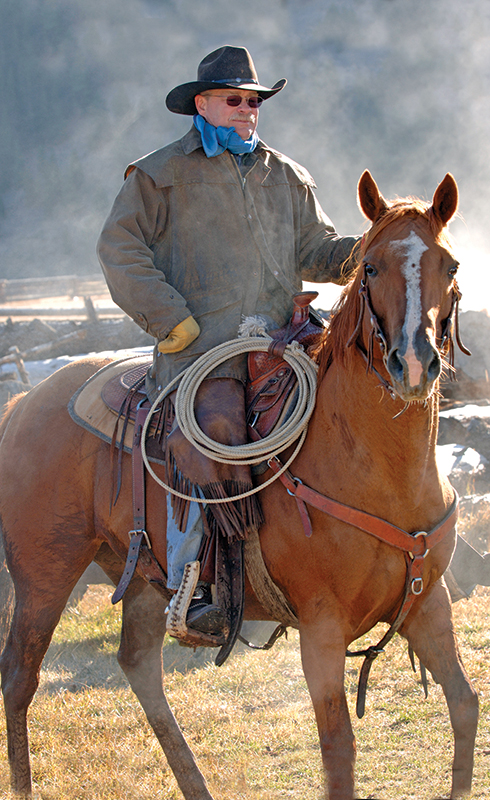
Cowboys must be able to look after themselves, and comfortable being on their own. They are tough and resilient enough to saddle up and go to work outside all day without complaint in winter’s worst weather. Photo: iStock/CG Baldauf
Without that mentorship or one-on-one guidance, cowboys today have to be savvy, self-reliant, and know they can depend on their horse and often their dog in managing cattle. Ramstad was inducted in the BC Cowboy Hall of Fame in 2013 for his contribution to successful ranch management not only at the Gang Ranch but at other significant ranches in BC.
“The cowboys have to be independent, able to look after themselves, and know that they won’t get lost,” says Ramstad. “They must be comfortable being on their own and able to think for themselves. I guess there has to be some resiliency to them, some plain toughness, and it may not be that obvious from an outsider point of view. If they aren’t here [at ranch base] sorting cattle, they are out in the camps or living in a cabin holding cattle and working cattle. It could be minus 30 degrees and the wind’s blowing. Yet they do it and you seldom hear a complaint. They’ll say it’s cold but they saddle up and go to work. The wind’s the killer. They aren’t doing anything that is active enough to help them stay warm. They are sitting on a horse holding the backside of a herd of cattle while the foreman does the cutting. But even that doesn’t keep you completely warm.”
In the spring, cowboys come from other ranches looking for work. It is a seasonal shift. Ramstad says that some would come from Alberta and Saskatchewan. But ranches, especially the big ones, have broken up to become smaller family ranches so the tradition of cowboys moving around has lessened.
“We don’t get the native cowboys anymore,” he says. “In our area - the Chilcotin and even in the Nicola Valley - a number of the crew would be native. But they’ve lost touch with horsemanship and cattle and the young people just aren’t interested. When I started there were always a number of native cowboys on the crew but you don’t see that anymore. Now it’s really difficult and I don’t know exactly why. Things have changed.”
However, not all cowboys start out with a ranching background. The foreman in charge of the cowboys at the Gang Ranch is Jason Woolsey, who made a career change when he saw an opportunity for work riding cattle on a ranch.
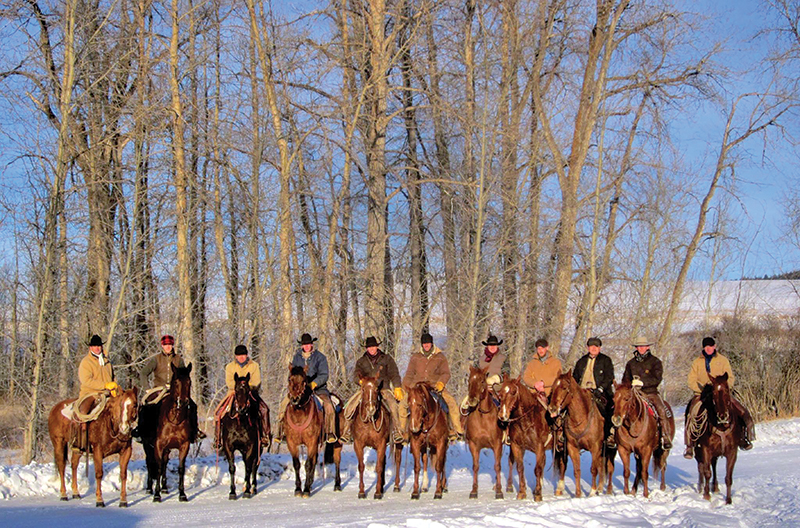
Cowboys and their horses at the Douglas Lake Ranch herd, ready for winter work. Each cowboy has a string of several horses and rotates them throughout the year. Photo courtesy of Douglas Lake Ranch.
“I came from a construction family and did what my father and brother did,” he says. “But I didn’t like it. I decided to move into a ranching region. I was one of those people who didn’t realize it [cowboying] was still a job. I didn’t realize you could ride full-time and get paid for it, and I thought I’d have to get my riding in on a volunteer basis. It was quite a career shift. I’m 32 and I’ve been doing it for five years now.”
Woolsey stresses the importance of patience and adaptability for today’s cowboy.
“Patience is a big thing,” he says. “So is endurance. They have to be really adaptable and resourceful. They have to be able to deal with isolation and that’s where adaptability and resourcefulness help. They have to be okay with being alone when they need to be. But we do lose a lot of people because of the distance from town and lack of social life. It’s a challenge. We have people coming and going, trying it. Then there are career people looking for a different region to work in, moving from ranch to ranch. I guess there are fewer cowboys but there are lots who are interested in it.”
Originally, cowboys were called vaqueros (from the Spanish word vaca for cow) and, anglicized, the word became buckaroo. They developed roping skills using braided rawhide known as reata (lariat), and livestock production became a thriving industry that continued to spread across the southwest into California.
Cowboys would become defined not only by their skills on horseback but by what they wore. And, today, the buckaroo style of the modern cowboy is just as popular and practical as it was over a century ago.

Larry Ramstad, manager at the Gang Ranch, checks the herd in early spring. Calving season starts at the end of February and continues through March. Photo courtesy of Gang Ranch.
“In a lot of the bigger ranches like the Gang Ranch and Douglas Lake Ranch, the cowboys dress in the period,” says McMillan. “If you go to their ranches you’ll see their cowboys are dressed in buckaroo gear, like that of California or Mexico.”
Their dress, of course, will be dictated by the weather and the season.
“They dress well but, in winter, they don’t look so fancy,” says Ramstad. “They’ve got big, floppy hats and ear flaps and scarves and old coats and boots — anything to keep them warm. In summer they wear traditional gear with chaps, neck scarves, hats, etc. Silk is always the best for a scarf as it wicks away moisture. Their chaps are traditional right down to the fringes. The fringes were designed, particularly in the days of buckskin, to take water away from seams. Rain would drip off the fringes instead of going right through the clothing. There’s a real utility to everything.”
McMillan agrees that there is practicality to the gear. Those boots, chaps, long-sleeve shirts, and hats were all designed and worn for protective purposes.
Starting at the top, the iconic wide-brimmed Stetson hat protects against the sun, the rain, and the dust, and can double up as a pillow when push comes to shove. The hat was designed by hatter John B. Stetson who was born in New Jersey in 1830 and started his hat business in Philadelphia. He spent a lot of time with cowboys and settlers heading west, and his design revolutionized their head gear. The first real cowboy hat became known as the Boss of the Plains. It kept the sun out of a rider’s eyes and off his neck. It acted like an umbrella when it rained. It gave them a bucket (the crown) to water a horse and a cup (the brim) to water themselves. It was a great fan to start a fire and a great tool to wave when shunting cows in one direction or another. The hat was – and is - so popular that its design has remained basically unchanged since the first hat came on the market in 1865.
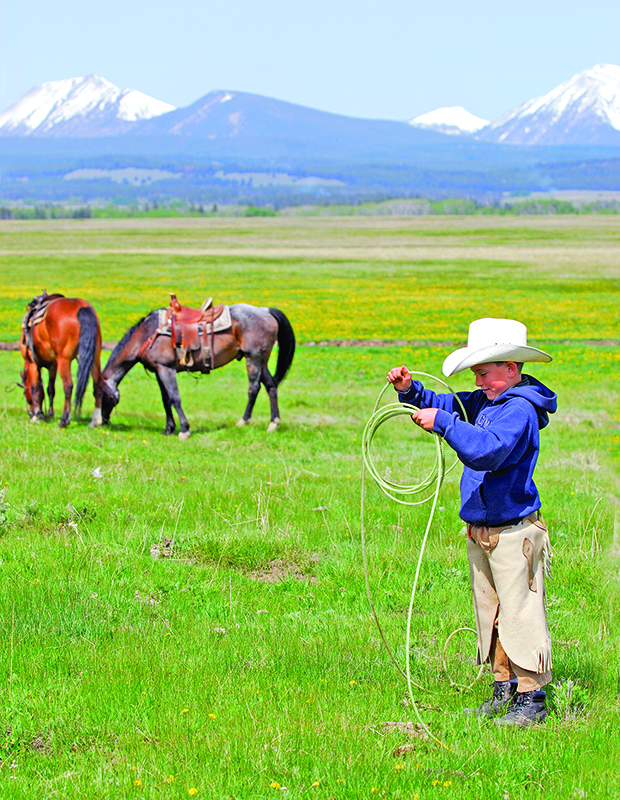
Photo: iStock/CG Baldauf
Long sleeved shirts protect from sunburn and insect bites, a vest adds extra protection from the wind and the cold, chaps over jeans protect from scratches and tearing when riding through bush in search of cows, and boots with a heel prevent the foot slipping through the stirrup. Form clearly has function.
The efficiency of a cowboy is depends greatly on the abilities and intelligence of the horse he is riding.
“They are all well-bred Quarter Horses,” says Ramstad. “There’s the Hancock stallion, and I have Spoon N Cinnamon and he would be a double-bred Bueno Chex that goes back to Poco Bueno. Bueno Chex is a great dam sire. They have good cattle working lines and, for the most part, they are a good size, good-boned with good feet and heart. Most have a number one shoe. But the horses are not as big as they used to be. They were a taller range horse when I first came here [in 1990]. We did long rides. But it’s not a requirement anymore. Now there is more trailering and trucking. Horses are 15.1 to 15.2 hands. I worked on a place previous to this one where they sold horses to the police force. The sergeant would come to pick what he wanted. They had to be solid-coloured geldings, bays or browns. He had his measuring stick and they wanted 16 hands. You would think you had 16 hands until he put the measuring stick against them. Everyone thought their horses were tall until they were measured.”
For personality, Ramstad says the horses need to be quiet. Their disposition can make the difference between a good day’s work or frustrating, even dangerous, situations. It makes a huge difference to have an animal a rider can trust. Ramstad says, though, that if a horse is more difficult to ride they can get passed over in the choice of which mount to saddle for the day. As a result, the more difficult horse won’t get the experience it needs to develop into a reliable mount.
Part of that reliability comes from horses getting to know their environment and where they are going, and building their own self-confidence. A horse will instinctively look after itself, read the landscape, and notice things that are of value to the cowboy. If the horse cues on eagles or ravens circling, it will be an alert for the rider to check out what they are doing, what they are circling above. It could be a dead calf or cow.
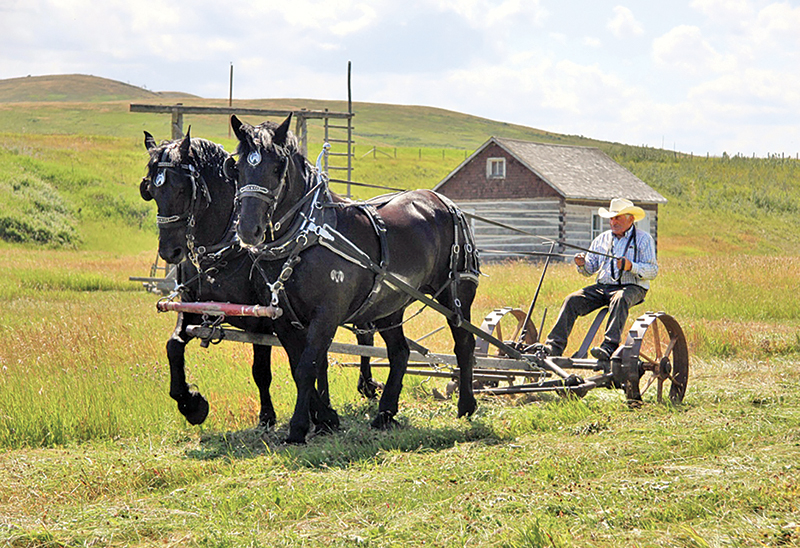
Traditional horse skills on the Bar U Ranch include driving teams of Percherons. Photo courtesy Parks Canada.
The stallions, too, are used as working horses. “They all have really good temperaments,” says Ramstad. “They are used as ranch horses. They trailer with other horses and they work just like a saddle horse. Whenever they are not out in the pasture for breeding they are used just like the other horses. It does them a lot of good too. It gives them something to think about. Even when they are not in the barn or being ridden, I keep them with other horses so they might be running with geldings and they keep their minds straight.”
Each horse has its own personality and they all excel at different things. They need endurance since they cover so much ground in a day. They have a quiet mind so they will not spook at the slightest thing. They have a willingness to get along with people, and they are observant watching cows.
The high country where the cattle range is wilderness where black and grizzly bears, cougars, and wolves are all residents.
“In the spring are black bears,” says Woolsey. “They’re around where the calves are. Then there are wolves. We’re always trying to stay on top of them and we see sign of them. The biggest pack I saw was 16 animals. They were all lying out on a frozen creek in a meadow.”
The cowboys do their own training with their horses but sometimes, Ramstad says, they have people in to help start the colts. But once they are started, the cowboys are expected to continue their training. In addition, cowboys have dogs to help with cattle work, all of them Border Collies or Border Collie crosses. They are invaluable when finding cows in heavy bush. Their bark will lead the cowboy to where the cow is. The horse must be tough and sturdy to navigate through brush and downed timber to get the cow out.
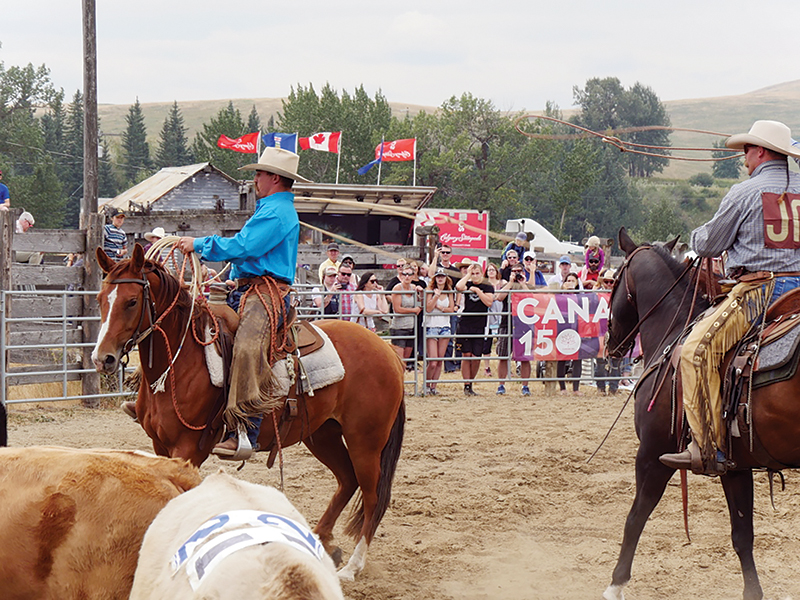
Cowboys at the Bar U Ranch National Historic Site help to connect Canadians to the story of ranching. Bar U cowboys are shown competing in the annual Old Time Ranch Rodeo. Photo courtesy of Parks Canada.
“A cowboy has about four, maybe five, horses and they rotate them every month or two,” says Ramstad. “But in summer they could have more.”
Woolsey says that, once a cowboy has been working at the ranch for a year, he could have as many as 12 horses in a string. Those horses have to be reliable workers, especially when the cowboys leave headquarters to go to the backcountry camps for the summer.
“When they leave headquarters in the spring they move to camp where there are horse pastures and they take a string of horses with them,” says Ramstad. “If we have seven or eight men going, they will take 30 or 40 horses with them. There could be four or five camps spread out and they may be anywhere from 50 to 80 kilometres away from headquarters. All the camps, vehicles, houses, and equipment are equipped with two-way radios so everyone can stay in touch.”
That is essential, especially when emergencies happen. Last year the ranch was faced with the massive wildfires that swept the British Columbia Interior.
“It was tough for a couple of weeks,” says Woolsey. “A lot of our range burned but the stuff that did burn was thick and tough and needed to burn anyway. It shouldn’t be negative in the long term with new growth coming back. We lost one or two cows but there may have been more, we’ll never know about.”
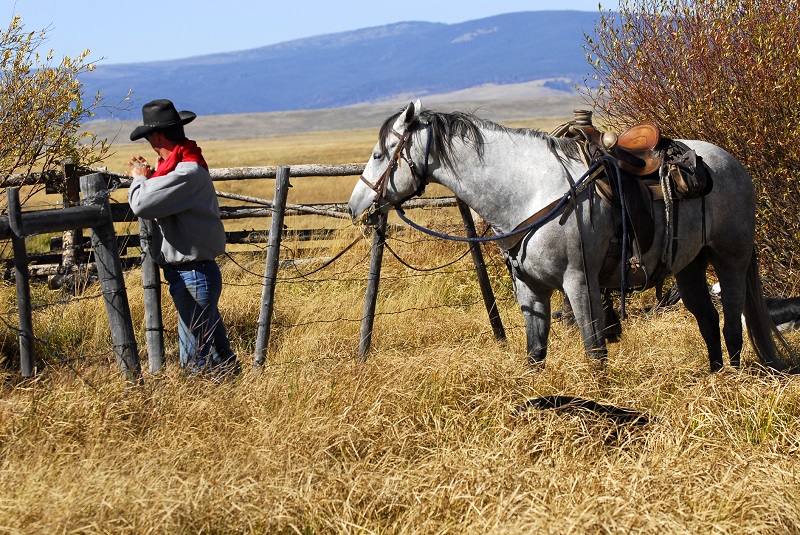
Today’s ranch hands are tech savvy, and many are seeing the potential of using drone technology in traditional jobs such as checking fences and finding lost cattle. Photo: iStock/CG Baldauf
The seasonal cycle is beginning again. Winter is the time when odd jobs and projects get done. Calving will start around the end of February and go through March. May and June will be branding time and, after that, the cows will be driven to the summer ranges where they will stay until fall when they are gathered and returned to home base. Everything, though, depends on the crew and the weather.
The 21st Century Cowboy
Better ways to track cattle is a continuous need and new technologies in electronic tracking and monitoring are providing valuable tools for cowboys and ranchers.
“Knowing our neighbours and in conversation with some of them, they use technology for crop/pasture management as well as computer programs to track herd health and day-to-day ranch/farm management,” says McLean.
For the past 20 years, Canada’s traceability system has been based on animal identification, premises identification, and animal movement. Led by the Canadian Cattle Identification Agency (CCIA), the program is focused on the containment and eradication of animal disease. Each animal in Canada must have a CCIA-approved ear tag before leaving the farm/ranch of origin. These radio-frequency identification (RFID) tags have a unique number and are recorded in a national database so, at all times, the animal’s movements can be monitored and, in the event of a serious animal health issue, it can be traced to its herd of origin.
Taking that a step further is drone technology that would allow individual tracking of each cow with unmanned aerial vehicles (UAVs), a tool that could make a cowboy’s work a lot easier in many areas.
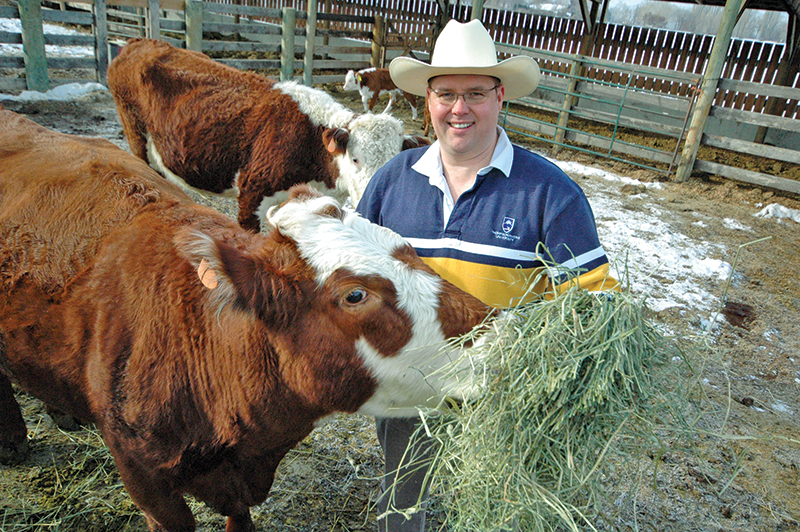
John Church is an associate professor and BC Innovation Chair in Cattle Industry Sustainability at Thompson Rivers University in Kamloops. His job is to explore innovative technologies leading to the sustainability of the cattle industry and rangelands. Photo courtesy of Thompson Rivers University
Drone technology has been the research focus of John Church, associate professor and BC Innovation Chair in Cattle Industry Sustainability at Thompson Rivers University in Kamloops.
“We’ve been working on more complex applications,” says Church. “Some of my honours students are looking at near infrared spectrum using multispectral cameras to assess vegetation and plants, and that’s been going very well. We can do large maps of a farmer’s fields and pastures. Through a science called photogammetry [photography to measure distances between objects] we can get a pretty good estimate of plant biomass and how much is there. And we can use the same drone to find lost cattle.”
Applying the concepts of precision agriculture to precision ranching, Church was awarded a three-year $663,940 grant in September 2016 which, along with additional contributions from partners, provided $1.1 million to further drone research. He has been working with Southern Alberta Institute of Technology (SAIT) and Jeff Braisher with Kingsclere Ranch in Golden, BC who has also been working with SAIT since 2014 on an ear tag development project. Their research has focused on higher strength, longer lasting polymers, integrating next generation UHF inlays, and improving retention so that the tag does not fall off the ear. But permanent tag retention still remains elusive.
“We are still testing,” says Braisher who runs 300 head of breeding cattle and another 125 replacement cattle. “You can simulate in a lab but you can only take it so far before you have to work with the animals. It takes time to do that.”
Drone technology has come a long way and many ranchers are seeing the immense potential of using them for herd surveillance and management. Drones can be used to track plant growth and health, check fence lines for damage from wildlife, check gates to ensure they are open/closed and not inadvertently interfered with by hunters, check water sources, look for weather event damage, survey pastures and woodland, identify diseased tree stands, monitor the spread of invasive weeds, and keep track of livestock. This is not to take away from a cowboy’s responsibilities but to aid in greater efficiency.
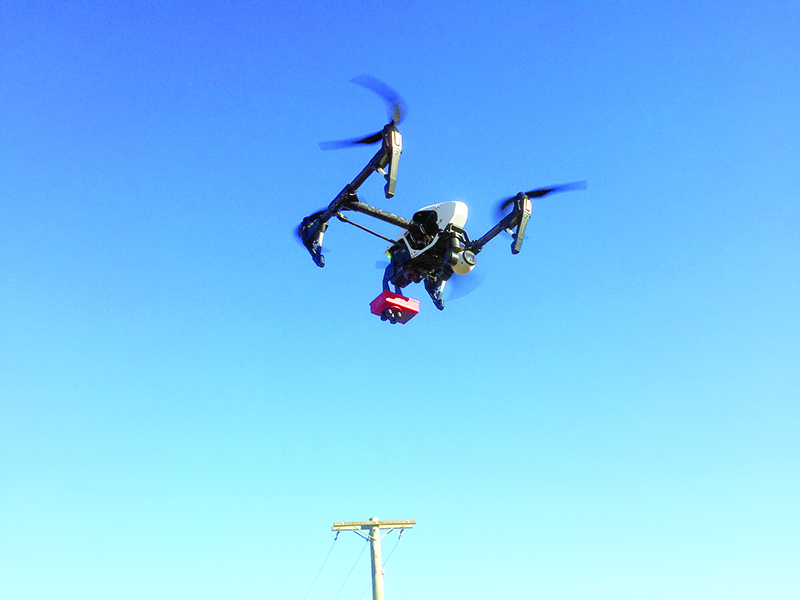
A DJI drone with multispectral camera. Students at Thompson Rivers University are using these drones to assess vegetation, create maps of fields and pastures, and estimate plant biomass, as well as to locate lost cattle. Photo courtesy of Thompson Rivers University
“Drones have really caught on with the ranching community,” says Church. “At least a dozen ranches are using them and more and more ranchers [are] showing interest every day. It’s been transformative technology. I have had ranchers in Alberta and Saskatchewan using them and many are very excited about the technology.”
According to Transport Canada, drones must be operated within a continuous line of sight, but in ranch country away from urban areas this opens up a wide expanse of landscape.
“Right now, we can do five to seven kilometres, but we can potentially go as far as 10 kilometres with the right antenna,” says Church.
A drone would be an ideal tool in a cowboy’s hand when looking for cattle below a ridge, in a grove of trees, or just beyond the crest of a hill. He’ll know where to ride to flush them out, saving many tiring hours of conventional searching. And a drone, which can be launched almost anywhere on the ground or off the back of a truck, is vastly less expensive than contracting the use of a helicopter or fixed wing aircraft. Battery life for flight time is around 20 to 30 minutes so back-up batteries are necessary. A rancher can get started with an efficient drone for around $2,000.
“One cow saved is more valuable than that,” says Church. “There’s a lot of interest in using a drone when turning cattle out in a new pasture and you have to check the fence line. They can be used for checking water sources and monitoring problem wildlife. A drone can let ranchers monitor game movement or the presence of predatory animals. A cowboy can do the follow-up work to continue to monitor the identified area.”
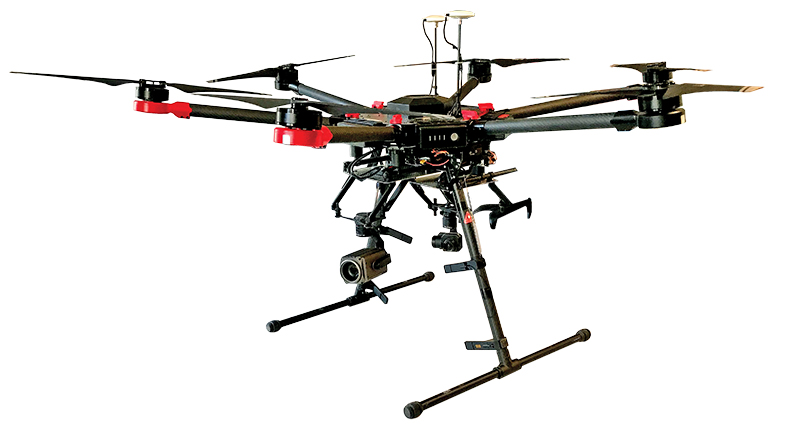
Thompson Rivers University (TRU) M600 drone with infrared thermographic (IRT) and super zoom cameras. Photo courtesy of Thompson Rivers University
Drones have caught on across the prairies.
“I know that at least one of our neighbours has purchased a drone and is quite excited about its possibilities in monitoring herd health as well as the state of pastures and fences,” says McLean at the Bar U Ranch.
There’s some experimenting when drones are first used on cattle. Braisher used a drone to move along some stragglers and had cowboys on the ground watch reactions. If the cows got excited, he would back off with the drone while the cowboys kept the cows in check.
“It seemed to go pretty well,” he says. “The cows moved and did their thing and seemed to learn and move away from the thing that sounded like a swarm of bees. At the time we chalked it up as good. But, later on, the cows remembered that. It took a long time for them to be conditioned not to be afraid of it.”
Today’s drones are small (some models fit into a saddle bag), tough, and fast with active collision avoidance, vertical take-off and landing, and a return-to-home function. Braisher says that it is not only the younger people who love this technology but older ranchers who see a valuable tool to help in the entire spectrum of cattle management. It’s a way to make today’s industry more efficient and cost effective.
Ramstad agrees. He is looking into the application of drones for his cowboys’ use and is appreciative of the tech savvy nature of today’s ranch hands.
“It will definitely happen,” he says. “You need skills other than the direct cowboy skills for this.”
Woolsey sees it in their future for better handling of cows. “They would be an extra tool to save time and be more efficient, especially with the right software. This time of year (winter) we are always driving and someone will tell you about cattle tracks. We have to go find them and sometimes they are just standing on the road. But with a drone we could be specific about where they are quickly and drive them out.”
Gang Ranch cowboys are tech savvy with social media on their iPhones. With Wi-Fi in the cookhouse and the TV room, everyone is on their iPhones in the evening enjoying the social connection.
And speaking of iPhones, the Canadian Cattlemen’s Association has been working on a smartphone tag reader and app that is being field-tested. According to an article by Debbie Furber in The Beef Magazine, the Herdly iPhone app and software for Mac and PC may go to market in time for the calving season this year.
But for all the tech innovations, Ramstad sees a downside at the ranch.
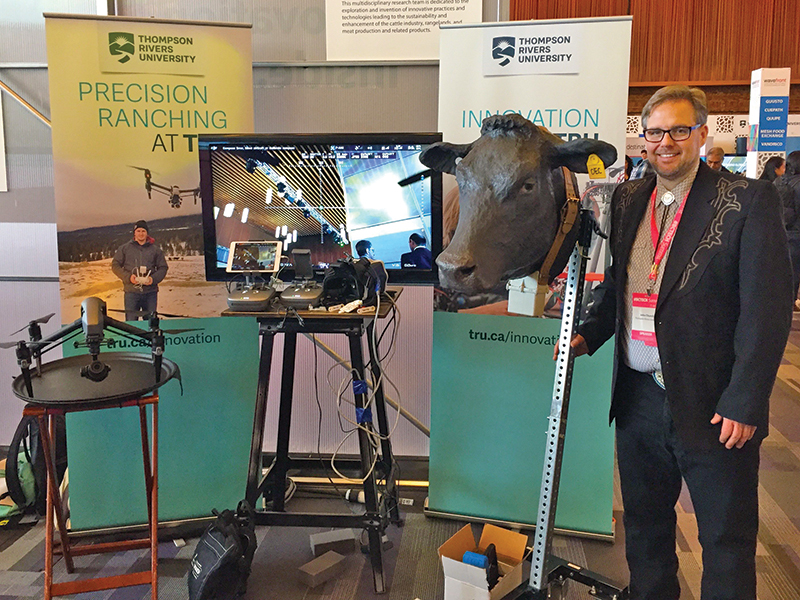
Dr Church with a cattle drone at the BC Tech Expo. Photo courtesy of Thompson Rivers University
“I notice here that you walk into the cookhouse and people used to be laughing and joking,” he says. “But now they are just on their iPhones and look at it while eating. That can isolate people.”
For Ramstad, tradition - and in no small way manners - are important and they go a long way in keeping the Gang community connected at an essential level. Perhaps it comes back once more to mentoring.
“Mentoring can be the small things,” he says thoughtfully and without being judgmental. “Even saying ‘good morning’ and ‘thank you’ to the cook. It’s basic manners. In the old days, young workers had that. Now, it doesn’t take them long to pick it up and generally the young guys are good and the young ladies too, as we’ve had young ladies do the job as well. They pick up on it the first day or two by hearing other people around the cookhouse.”
Many might wonder about the future of cowboys, and some have no idea that cowboys still manage cattle but, as Ramstad says, they are here to stay.
“As long as there are cattle there will be some form of cowboys, especially in British Columbia where we depend on the forest ranges for permit land [where horses are needed to penetrate the bush]. ATVs [all-terrain vehicles] have their uses in parts of the province, but in Douglas Lake, the Nicola Valley, you don’t want any kind of vehicle going on grassland because of environmental standards.”
McLean agrees with that and, while technology will advance a cowboy’s reach, it will not take away from the traditional need for cowboys on horseback.
“As today’s agricultural industry becomes more efficient, fewer people are required to do the same tasks,” says McLean. “While off-road vehicles, tractors, and trucks have made it easier to feed the cattle and maintain fences, there’s nothing like a horse to check or move a herd. The horse also helps to preserve the native grass pastures of the foothills with an ecologically friendly footprint. Today’s ranching families along the eastern slopes of the Rocky Mountains embrace many modern innovations to remain competitive in today’s marketplace, but the horse still plays a prominent role in herd management and sustainability of the landscape. The Bar U Ranch started on the open range and developed fenced pastures, irrigation, farming, new market niches, and intensive livestock operations. Today’s cowboy continues to carry that torch forward.”
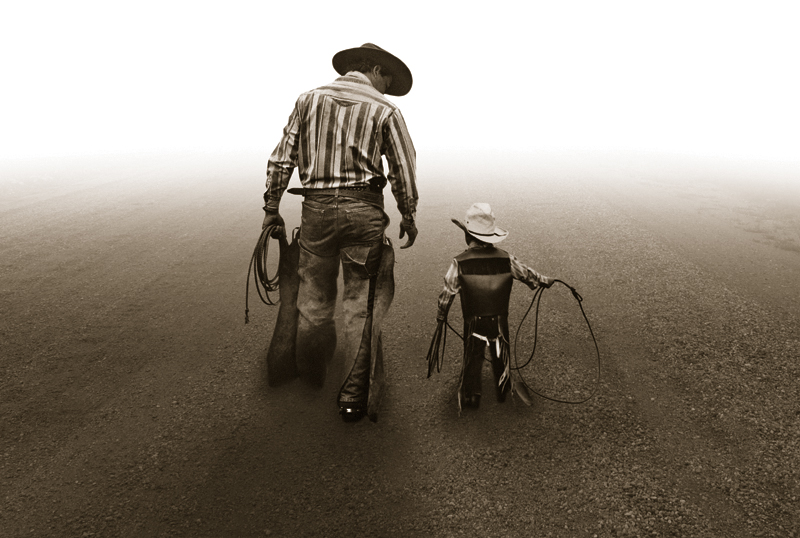
Photo: iStock/RandyJayBraun
They will endure, McLean says. Skills will endure through competitions such as rodeo and ranch roping, and on the range as long as ranching continues to be a viable industry. Innovation will be key and is surely part of the enduring cowboy’s legacy.
Main photo: The Great American Horse Drive takes place every spring in northwest Colorado, when the Sombrero Ranch horses come off their winter pasture to begin another year working on dude ranches and summer camps. The ranch owns about 1000 head of horses, and herd sizes for the drive range from 350 to 800 head. Pictured is Zane Bishop participating in the 2012 Ride. Zane’s grandfather Rex Walker started Sombrero Ranch and this horse drive has been an annual tradition for over 50 years. Photographer Carien Schipper tells us she’s been shooting this event for 12 years. “It is a spectacular event, the highlight of my year.” ©Carien Schipper



